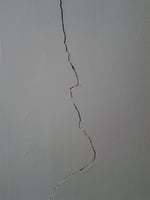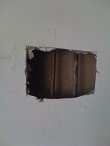
In this article:
There are many methods for repairing damaged drywall. The method you chose depends a lot on the type of damage. This article outlines several types of drywall damage:- Drywall Cracks
- Holes in the Wall
- Dents, Nicks, and Scratches
- Nail Pops
Types of Drywall Damage and Drywall Repair
There are a few different types of damage that can happen to drywall. Knowing what method to use when repairing damaged drywall depends a lot on the type of damage that occurred. Drywall repair can be broken down into the following categories:
- Drywall Cracks
- Holes in Drywall
- Nail Pops
- Drywall nicks, scratches, and dents
- Corner Bead Damage
Repairing Drywall Cracks
 No matter how hard you try, it is difficult to completely prevent drywall from cracking. Many times, if a drywall joint, seam, or corner is going to crack, it will happen within one year after completing a drywall project. Cracks occur when some type of movement occurs in the underlying structure. The movement could be because of poor framing or improper drywall installation.
No matter how hard you try, it is difficult to completely prevent drywall from cracking. Many times, if a drywall joint, seam, or corner is going to crack, it will happen within one year after completing a drywall project. Cracks occur when some type of movement occurs in the underlying structure. The movement could be because of poor framing or improper drywall installation.
How do you repair drywall cracks? What type of drywall mud is best for repairing drywall cracks? What type of drywall tape should be used when repairing drywall cracks? Please read some of the following articles to learn more about repairing drywall cracks.
Repairing Holes in Drywall
 There are a number of reasons why you may need to repair drywall holes. For example, when electricians install or move lights or outlet boxes, there are usually holes left behind that need to be repaired. If a door does not have a good door stop, it can slam into the wall causing the door nob to create a hole.
There are a number of reasons why you may need to repair drywall holes. For example, when electricians install or move lights or outlet boxes, there are usually holes left behind that need to be repaired. If a door does not have a good door stop, it can slam into the wall causing the door nob to create a hole.
Holes in walls come in many shapes and sizes. For this reason, you may need to use different techniques for different types of drywall repair. Some times a small wall patch is sufficient but other times, you need to install new backing and large pieces of drywall.
Please read up on some of our articles that describe different methods of repairing holes in drywall walls.
Repairing Drywall Nail Pops
 A common form of drywall damage is nail pops. Nail pops look like small round indentations on the drywall surface. When a nail or screw pops through the surface, it causes the paint to crack around the nail or screw head.
A common form of drywall damage is nail pops. Nail pops look like small round indentations on the drywall surface. When a nail or screw pops through the surface, it causes the paint to crack around the nail or screw head.
Screw pops are caused when the underlying screw or nail breaks free from the backing below and allows the drywall to move away from the underlying backing.
Most of the time screw pops are caused by improper hanging technique. Either the screw was set too deeply, causing the drywall paper to rip, or not enough fasteners were used, which can lead to movement. If not enough fasteners or the wrong type of fasteners were used, you will oftentimes see both nail pops and cracked seams in the same area.
Drywall nicks, scratches, and dents
Although there are many advantages to drywall over plaster, one disadvantage is that it is easier to damage drywall than it is plaster. It is very hard to prevent all drywall nicks, scratches, and dents. Small drywall dents or scratches can happen when moving furniture or other items.
The good thing is that minor drywall damage is easily repaired. Many times you don't even need to use drywall mud. Wall spackle can be used to fix minor drywall damage. One advantage of spackle in this case is that it dries quickly and does not shrink. That means you can paint it soon after doing the repair.
Please read our other articles that talk more about how to repair minor drywall damage such as nicks, scratches, and dents.
How to Match Drywall Texture
After you have repaired the damaged drywall, you may need to re-texture it. Matching drywall texture is no easy task. First, you need to determine what type of texture was originally used. But even when you know the type of texture you are trying to match, finding the right materials, tools, drywall mud, and technique can be very challenging.
You can read more about different types of common drywall textures here. Scanning through some of the types of texture we have on this site can help you to identify what type of texture was used in the first place.
But as mentioned, matching an existing texture is no easy task. You can check out this article to find tips for matching drywall texture. If you are looking to match a spray knockdown texture, you will want to read this article that describes a specific tip and technique for matching Spray Knockdown Texture.
In Summary
There are a lot of different types of drywall damage and many different methods of repair. Selecting the best repair method depends on determining the cause of the damage. If you aren't sure where to begin, please start with the link below that takes you to an introduction to repairing drywall cracks.
